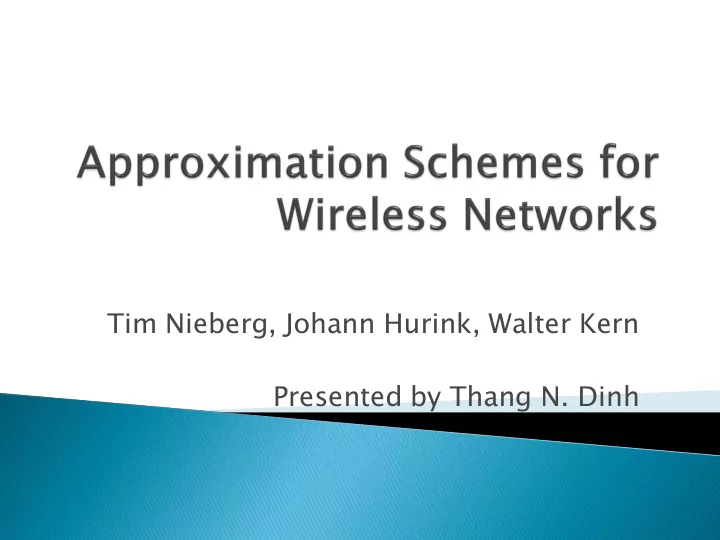

Tim Nieberg, Johann Hurink, Walter Kern Presented by Thang N. Dinh
PTAS for Max (Weighted) IS and Min DS for Wireless Networks ◦ WITHOUT geometric information ◦ Work for various Wireless Models: Disk Graph , Quasi-Disk Graph, Fading, .etc. ◦ Detect if the underlying graph is not UDG, DG, .etc (UDG recognition is NP-hard) ◦ Simple algorithms.
Wireless Communication Models I. Maximum Independent Set and Minimum II. Dominating Set Polynomial Bounded Growth Graphs III. Local Neighborhood-Based Approximation IV. Schemes
V U • Node u: (p u : location, A u : coverage area ) • Containment model vs. Intersection model
UDG - Idealistic model: Omnidirectional antenna, no obstacles, identical power level,… Disk Graph: different transmission ranges Quasi-Disk Graphs: Fig 1. Unit Disk Graph Fig 1. Quasi-Disk Graph
Min Weight IS has PTAS in Planar Graphs[B83], UDG[HM85], DG[EJS01] Min DS: PTAS in Planar Graphs, UDG, ??? in DG
f-growth-bounded : Every r – neighborhood in graph contains at most f(r) independent vertices Polynomially bounded: f = O(r k ) UDG, DG, Quasi-Disk graph are polynomially bounded (Disk fitting).
1. Pick up an arbitrarily vertex v 2. Loop until | 𝐽 𝑠 | 1 + 𝜁 > | 𝐽 𝑠 +1 | 3. Take I r and remove all vertices in (r+1) hops from v and repeat. Where I r is the optimal IS of nodes at distance at most r from v
( ) ( ) ( ) S I v I v I v Our solution r r r r ( ) ( ) ( ) S I v I v I v OPT 1 1 1 1 r r r r | | (1 ) | | S S 1 r r
Correc rectn tnes ess: Union of all sub Independent set is an independent set (all regions are 1- separated) Polyno ynomial ial runtime ime: ◦ There exists such that ◦ Proof: (Exponentially) Number of vertices in I r at most r k ( polynomially ) c =
Using same algorithm Pick up the vertex with max weight left at each iteration
Vertices outside can dominate vertices inside Stop condition: Polynomial time:
Q&A: ◦ Can we extend the solution for Weighted Min DS?
Recommend
More recommend